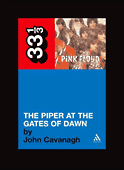 Pink Floyd's The Piper At The Gates Of Dawn is not only one of the seminal psychedelic albums of the 60s, but is also famous for being one of the few existing exposes of the phenomenal creative talent of the elusive Syd Barrett. It bizarrely takes its title from a chapter of Wind In The Willows by Kenneth Grahame, and many of the tracks, such as Bike and The Gnome, exhibit a similar air of playful, childish fantasy. With the loss of Syd's lyrics after his psyched-out departure, Pink Floyd had little choice but to move in different creative directions. Pink Floyd's The Piper At The Gates Of Dawn is not only one of the seminal psychedelic albums of the 60s, but is also famous for being one of the few existing exposes of the phenomenal creative talent of the elusive Syd Barrett. It bizarrely takes its title from a chapter of Wind In The Willows by Kenneth Grahame, and many of the tracks, such as Bike and The Gnome, exhibit a similar air of playful, childish fantasy. With the loss of Syd's lyrics after his psyched-out departure, Pink Floyd had little choice but to move in different creative directions.
John Cavanagh's book, however, is most emphatic on one point: "This is not another book about mad Syd." The legend of acid-addled Syd has spawned countless books, articles, obsessions - even a DVD of his first mushroom trip. But the very fact that Pink Floyd managed not only to continue, but to evolve after Syd's departure shows that the success of The Piper At The Gates Of Dawn was not merely due to Mr Barrett.
John Cavanagh's book is refreshingly personal on two levels: Firstly, it offers us a look at the author's personal experience of the album, and also, through the comments of friends and acquaintances, a valuable insight into the early group dynamic and social background of Piper-era Pink Floyd.
Despite the personal perspective of the narrative, Cavanagh never lapses into painfully self-aware nostalgia. He includes numerous contributions from people involved in the creation of The Piper At The Gates Of Dawn, giving us a real sense of the genesis of the album (including some interesting information about the recording procedures of the time), the musical aesthetics and the group dynamic. Despite its brevity, Cavanagh's work presents an admirably well-informed and comprehensive analysis of its namesake. Cavanagh, through the testimonies of former acquaintances, explores Pink Floyd's connection with the UFO (Underground Freak-Out) hippie crowd after their move to London, and the transformation of their long, rambling live sound in the studio to create the relatively tightly-structured Piper.
Basically, Cavanagh acknowledges, the songs Syd wrote could be fitted into a conventional pop structure. In live performance Pink Floyd simply explored the innate creative potential of the material, leading to long, drawn-out solos. What brings his narrative alive is John Cavanagh's obvious deep love of the music itself, coupled with a refreshing, respectful lack of obsession with the band members themselves. He describes at one point how, at the age of ten, he dreamed of visiting Syd in Cambridge, but has long since given up the misplaced desire to do so.
Perhaps the journalists who still attempt to hound Roger Barrett (Syd's real name) should take notice: Roger is not Syd, who ceased to exist after his departure from the music world. Syd Barrett lives on only through his music. The Piper At The Gates Of Dawn could never have existed without him, but it also could not have existed without the other close-knit band members. Forget the contemporary cult of celebrity and listen to the music. :: Hilary Davies |
 Pink Floyd's The Piper At The Gates Of Dawn is not only one of the seminal psychedelic albums of the 60s, but is also famous for being one of the few existing exposes of the phenomenal creative talent of the elusive Syd Barrett. It bizarrely takes its title from a chapter of Wind In The Willows by Kenneth Grahame, and many of the tracks, such as Bike and The Gnome, exhibit a similar air of playful, childish fantasy. With the loss of Syd's lyrics after his psyched-out departure, Pink Floyd had little choice but to move in different creative directions.
Pink Floyd's The Piper At The Gates Of Dawn is not only one of the seminal psychedelic albums of the 60s, but is also famous for being one of the few existing exposes of the phenomenal creative talent of the elusive Syd Barrett. It bizarrely takes its title from a chapter of Wind In The Willows by Kenneth Grahame, and many of the tracks, such as Bike and The Gnome, exhibit a similar air of playful, childish fantasy. With the loss of Syd's lyrics after his psyched-out departure, Pink Floyd had little choice but to move in different creative directions.